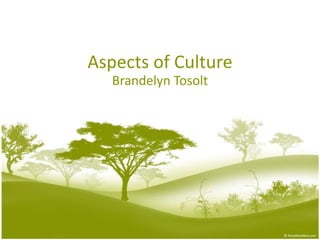
Aspects of culture
- 1. Aspects of Culture Brandelyn Tosolt
- 2. Thoughts on culture • There are many different ways to think about culture • Different theorists have developed a variety of different ways to think about cultures • It is not important to remember each of these ways, but rather to think about how these ways might influence what happens in your own life
- 3. Gardenswartz, Rowe, Digh, & Bennett (2003) • Personal: – individual’s traits, skills, and personality within context of ethnic, racial, familial, and educational environments – Everyone has a different personal culture. • National: – shared understanding from beliefs, values, attitudes, and behaviors that provide the foundation of a nation. – Everyone falls within a range. • Organizational: – widely shared institutional beliefs, values, and the organization’s guiding philosophy – Individuals fall within a range – An individual’s position in the hierarchy of the organization affects their view of organizational culture
- 4. Kluckhohn & Strodtbeck (1961) • Basic nature of human beings – good – evil – mixed • Relationships among people – individualistic – group – hierarchical (classes or castes) • Activity orientation – being (you are who you are) – doing (you are what you do)
- 5. Kluckhohn & Strodtbeck (1961) continued • Relation to nature – subjugation (we use it for our ends) – harmony (we co-exist) – domination (we’re in control) • Time orientation – what’s important is when things happen: – past – present – future
- 6. Hofstede (1984, 1985, 2001) • Power distance – The acceptable amount of inequality in power – Low power distance = expectation of equality • Uncertainty avoidance – Ability to tolerate uncertainty and ambiguity – Low uncertainty avoidance = tolerating ambiguity • Individualism/collectivism – Social framework privileging individual or group needs • Masculinity/femininity (NOT MALE/FEMALE) – Emphasis placed on emotional/social roles or work goals – Masculine = assertive, achievement, material success – Feminine = relationships, cooperation, quality of life
- 7. GLOBE (2001) • Global Leadership and Organizational Behavior Effectiveness Project Team • 170 researchers • 7 years of data • 18,000 managers in 62 countries • 9 cultural dimensions – 4 are Hofstede’s – 5 are new
- 8. GLOBE (2001) continued • Assertiveness – Emphasis on tough, competitive, and confrontational versus modest and tender • Future orientation – Emphasis on delayed gratification • Performance orientation – Amount individuals are recognized and rewarded for individual performance rather than belonging • Humane orientation – The amount of reward for being fair, caring, generous, altruistic, and kind • Gender differentiation – Emphasis on gender role differences
- 9. References Gardenswartz, L., Rowe, A., Digh, P., & Bennett, M. F. (2003). The global diversity desk reference: Managing an international workforce. San Francisco: Pfeiffer. Hofstede, G. (1984). The cultural relativity of the quality of life concept. Academy of Management Behavior, 9, 389-398. Hofstede, G. (1985). The interaction between national and organizational value systems. Journal of Management Studies, 22, 347-357. Hofstede, G. (2001). Culture’s consequences: Comparing values, behaviors, institutions, and organizations across nations (2nd ed.). Thousand Oaks, CA: Sage. Javidan, M., & House, R. J. (2001). Cultural acumen for the global manager: Lessons from Project GLOBE. Organizational Dynamics, 29(4), 289-305. Kluckhohn, F., & Strodtbeck, F. K. (1961). Variations in value orientation. Evanston, IL: Row.
